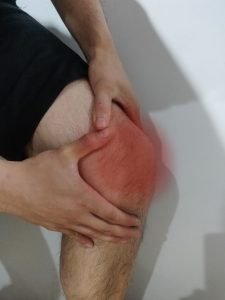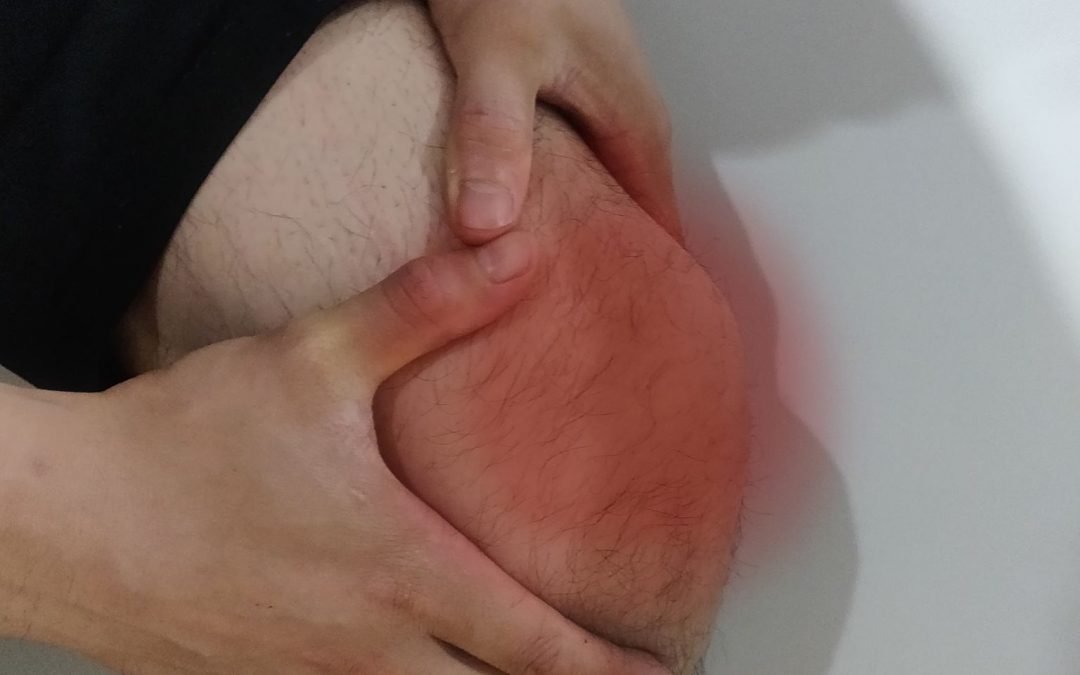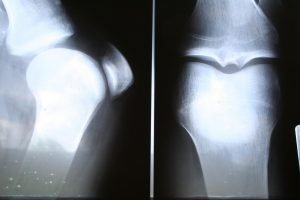What is knee pain?

Radiating Pain in the Knee Area
Every joint in our body is a complex organisation of different structures that include: bones, ligaments, muscles and tendons. To identify what knee pain you might be experiencing, there needs to be tests that will narrow down which structure is not functioning optimally.
There are differences between acute (short term) and chronic (long term) knee pains.
Most cases of knee pain start off as acute, from osteoarthritis, sprains, strains, meniscus injury or tendinopathies to give a couple examples. However, if any of these acute pains are left untreated they can lead to chronic pain.
One of the common knee pains comes from a knee sprain. A sprain is when a ligament (e.i. Anterior Cruciate Ligament – ACL) is stretched over the capacity that the ligament can withhold, and a tear in the ligament occurs. There are different grading systems for the severity of a sprain from Grades 1 (a minor stretch of the ligament/s with minimal to no tearing), Grade 2 (a partial tear of the ligament/s) and Grade 3 (a full tear of the ligament/s). The different grades will also come with symptoms varying levels of swelling, pain, and ability to put weight through the leg.
Comparing a sprain to a strain, a sprain is when the muscle (quadriceps) or tendon is stretched or torn and have a similar grading system to the sprains from grade 1-3.
Tendinopathies are also a common diagnosis from knee pains. Tendinopathy can occur when there is an increased load to the tendon that it is not used to (i.e. running 5km after a 2-week cruise vacation). This type of pain will most likely affect you in the mornings after the increased load. Tendinopathy, if not treated properly can become a chronic pain or lead to other injuries.
Speaking of chronic pains, one of the most common diagnosis that GPs give to clients coming for physiotherapy is Osteoarthritis (OA). So, what is OA?
OA in basic terms means that there is narrowing of the space between two bones, in this case, either the femur, tibia or patella. This can present in aching/stiffness when staying still for periods of time (i.e. sleeping or sitting at work).
What area of the body does knee pain affect? the type of feeling/pain/symptoms?
Since our lower body is always weight-bearing, any part of the lower limbs or back can be affected from knee pain. This can most likely occur from an altered walking pattern, as seen below:
(Hip Circumduction walking)
What behaviours causes knee pain?
The clients with a higher risk of knee pain include, athletes, older clients, or clients with previous lower limb injuries.
As stated above, knee pain can occur in a multitude of ways but some of the most common include:
Drastically increasing load (i.e. running for the first time in a while)
Contact Injury (bumping knees during footy/soccer)
Non-Contact Injury (stepping in a divot and spraining your knee)
How long does knee pain take to recover? why is it important to treat it early?
The recovery period can differ from 1-2 weeks to a full year or more of rehabilitation, depending on the type of injury/pain you are currently dealing with.
Treating it early can lower the risk of: developing chronic pain and/or injuring other areas of the body. Early treatment has also shown a faster recovery time.
So, making sure that you see a physiotherapist as early as you can to deal with your knee pain will help you get back to what you love doing.
How does physiotherapy help with knee pain?
Physiotherapists can assist with knee pain through various treatment styles from manual therapy, to prescribing the correct exercises to help the client get back on their feet.
However, the purpose of physiotherapy is not just to get clients out of pain but to also achieve their goals of getting back to sport, hiking, walking, or just being able to sleep without the knee aches.
If you are dealing with any type of knee pain or any other pain come through to see one of our highly-qualified physiotherapists to get you moving!
Conclusion about Knee Pain and Physiotherapy
Our Knees are a foundational main joint in our body. They are made to handle a lot of pressure and force but it’s still important to identify if it’s injured. Making sure they healed
completely again so you’re able to continue your lifestyle. If it does get worse you should definitely stop by and see a physiotherapist. They will be able to find which part needs to be worked on and provide the best
treatment to recover and improve its performance.
—
About Chris Choi & Primal Physiotherapy
Chris graduated from University of Melbourne with Doctor of Physiotherapy, having completed a Bachelor Degree in Kinesiology back in the USA. Chris is a certified strength and conditioning coach, with a mentality to get clients back to their favourite form of exercise. He has interests in all sports, both watching and playing! In his spare time, he is either on the golf course or enjoying his time with his puppy.
Chris is a Physiotherapist at Primal Physiotherapy which is a leading Physiotherapy clinic with state of the art rehab facility to help their clients return back to life, work, and exercise pain-free.
Primal Physiotherapy Braybrook
10/227 Ballarat Rd
Braybrook VIC 3019
(03) 9995 8044
https://primalphysiotherapy.com.au/braybrook
Primal Physiotherapy Taylors Hill
127 Gourlay Rd
Taylors Hill VIC 3037
(03) 8315 7182
https://primalphysiotherapy.com.au/taylors-hill
Primal Physiotherapy Camberwell
782 Burke Rd
Camberwell VIC 3124
(03) 9973 3090
https://primalphysiotherapy.com.au/camberwell


